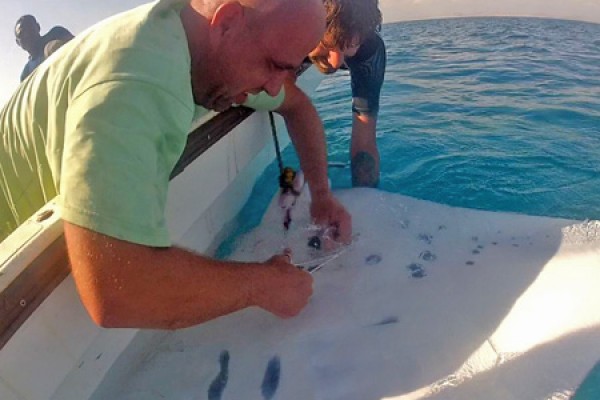 Nigel Hussey and Steve Kessel tag a manta ray in the Red Sea off the coast of Sudan.
Nigel Hussey and Steve Kessel tag a manta ray in the Red Sea off the coast of Sudan.
A rare type of hybrid manta ray has been discovered in the Red Sea thanks to the work of a trio of University of Windsor scientists and their research partners in Sudan.
The ray, a cross between a Reef Manta Ray (Manta alfredi) and a Giant Manta Ray (Manta birostris), is only the second documented case of hybridization in elasmobranchs, the subclass of fish that includes sharks and rays, according to the group.
 Ryan Walter. |
“Hybrid individuals are evidence of connectivity beyond a geographic or population context, ultimately blurring the definition of what we call a species,” said Ryan Walter, the post-doctoral fellow in the university’s Great Lakes Institute for Environmental Research who conducted the genetic analysis on DNA samples taken from the animal when it was caught, tagged and released in the marine protected area of Dungonab Bay, Sudan last fall.
While tagging, the scientists also collected small tissue samples from the animals, which were sent back to Windsor for analysis by Walter, who found similar genetic characteristics from both species in one sample.
Nigel Hussey and Steve Kessel, both post-doctoral fellows at GLIER, led a group of scientists on an expedition last year which involved attaching acoustic and satellite tags to manta rays in order to track their migratory patterns. The group included scientists from The Cousteau Society, The Deep – an aquarium and research facility in the U.K. – King Abdullah University of Science Technology, and partner institutions from Saudi Arabia and Sudan. They worked in collaboration with Wildlife Conservation General Administration, Red Sea University and Red Sea State Government of Sudan.
“There are known genetic differences between the two species, but it now appears that the genetic criteria that we have to date is no longer sufficient to define these species,” said Dr. Walter, who was the lead author on a paper describing the findings that was published in the academic journal Marine Biodiversity.
Until recently scientists only recognized one global manta species, but the genus was re-evaluated several years ago and two species, Manta alfredi and Manta birostris were identified. In a few locations, the two share the same habitat, but they typically follow different movement patterns and were thought to be reproductively isolated.
The overall aim of the research in the area is to address issues critical to conserving Sudan’s unique Manta Ray population. Both species are considered vulnerable, and the occurrence of hybridization stresses the importance for monitoring, conservation and management of threatened species, said Dr. Hussey.
“The marine protected area of Dungonab Bay is one of the few unique sites on our planet where an extraordinarily large number of these animals can be found,” he said. “The potential for hybrids to act as dispersal agents of genetic diversity may be a promising sign for these threatened species, but also raises questions about individual species management.”
